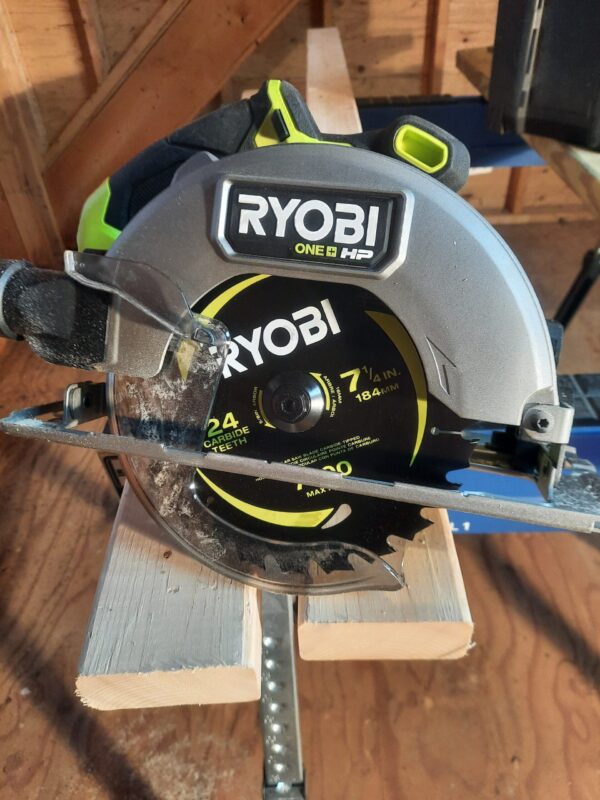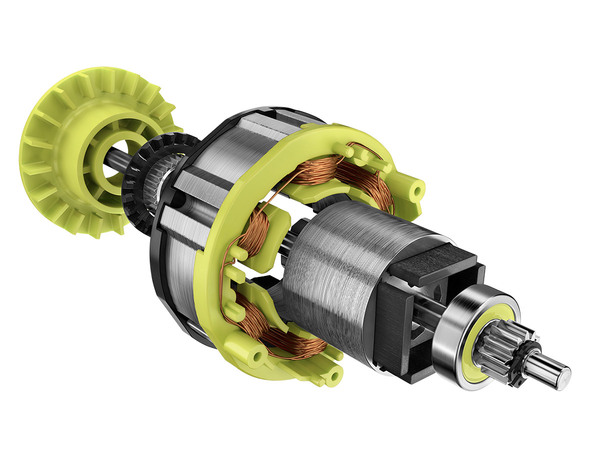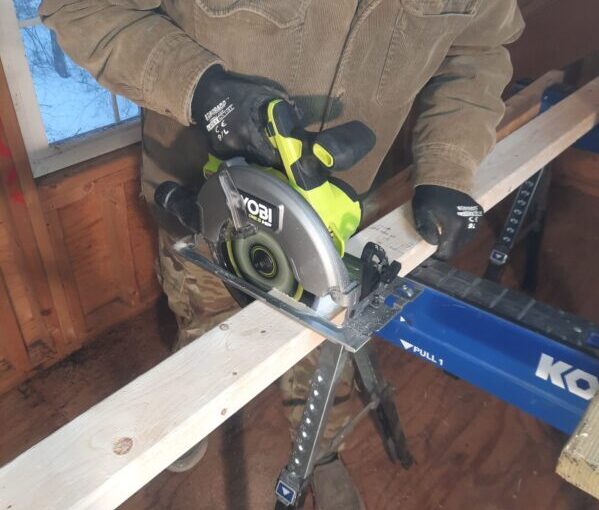How To Fix A Ryobi Circular Saw
Ryobi 7 i/4 Circular Saw PBLCS300 Review
If we had to choose a single cordless item for carpentry and construction, we would be hard-pressed to option against a 7 ¼" circular saw for basic cutting tasks. We use circular saws on everything from sizing 2×4 rough framing to doing plunge cuts on outside wall capsule. So when we recently got the chance to test out the newest Ryobi vii 1/4 Circular Saw PBLCS300, we took it. Nosotros tested information technology out cut some replacement ii×4 jack studs and framing for a porch rehab before installing windows and capsule. This gave u.s. a chance to test out design, features, and overall performance.

Ryobi PBLCS300 Features & Specifications
- Brushless motor delivers up to twoscore% faster cutting
- 0-56° bevel capacity for cut versatility
- Adjustable depth baby-sit for cut up to 2-7/16 in. depth of cut at 0° and i-3/4 in. at 45°
- Die-cast upper guard for increased durability
- Vacuum dust adapter is compatible with one-7/8 in. and 1-1/iv in. hoses
- On-board LED worklight to illuminate workspace for clear cut line visibility
Ryobi PBLCS300 Brushless Motor
The single biggest comeback included in Ryobi's PBLCS300 seven ¼" circular saw is the addition of a brushless motor. Past incorporating a brushless motor, Ryobi has achieved major advances in overall power, tool longevity, and bombardment life. A brushless motor eliminates internal castor-based friction by locating the permanent magnets on the outside of the copper coils. Information technology causes motor rotation based solely on the magnetic interaction of the coils and magnets by energizing the coils. This means no brushes to article of clothing out and supplant which causes the tool to last longer. It also ways there is less wasted free energy from the friction of the brushes and so more than power is delivered past the motor and the battery life is longer. That's a lot of words to say that the brushless motor in the Ryobi 7-one/4″ One+ Circular Saw PBLCS300 is a big deal.

Power & Performance
Nosotros found that the Ryobi 7-1/4″ One+ HP Circular Saw PBLCS300 cut fast, was powerful, and maintained speed/RPMs under load. Nosotros were pleased with this saw's overall cutting functioning, especially with a 4Ah +HP or greater battery pack. There were a couple of situations of note. Kickoff, we noted that the motor ran smoother with a thin-kerf bract vs a standard kerf blade. This is due to less overall material removal. Ryobi includes a thin-kerf blade with the PBLCS300 circular saw.
Nosotros also establish that the saw performed noticeably improve with a 4Ah +HP bombardment vs. a 2 Ah battery, even on initial cuts with a fully charged 2Ah battery. This is due to the smart HP+ chip electronics integrated into the PBLCS300 circular saw. The tool recognizes when a +HP battery is loaded and allows the motor to run at a higher RPM (4300 vs. 3700 with the P508). The 1+ tools also have scrap integration (P508) but the + HP lineup allows for additional battery power to be directed to the motor. We could hear some motor strain with 2Ah battery and the blade seemed to have a minimal amount of slowing. For the majority of the test, we used the 4Ah +HP bombardment to cut 2x4s and ½ plywood with zero issues.

Run-time
Ryobi didn't publish specific claims on overall runtime or number of cuts in a standard material. At Tool Box Buzz, nosotros feel that most of the major tool brands that are offering a full-size circular saw are using skilful lithium-ion battery packs along with brushless motors. And the anecdotal testing of this saw was great; we were able to get a typical half-mean solar day of intermittent use out of a unmarried 4Ah HP+ battery. Simply put, this saw should run long enough for the average worker to complete his or her work in a standard workday, with a battery change. Possessing 2 battery packs, and the fast charger ensures that the saw sees no downtime.
Cutting Capacity
The Ryobi 7-i/4″ One+ Circular Saw PBLCS300 bevels to 56 degrees and provides a 2-7/16″ depth of cutting at 90° and 1-13/16" at 45° (come across tabular array beneath). Adjusting the cutting depth and bevel angle aligning is seamless with the tool-free adjustable design for both functions. The overall adjustment action is smooth. The bevel lever is large and easy to firmly grip. The depth aligning is well placed to allow the operator to utilise the bombardment casing as a leverage point for one-handed depth adjustments. The depth adjustment has a depth judge with a small white marker to brand certain the bract adjustment is well matched to the material thickness. It is a scrap obscured behind the handle but otherwise very adequate.

- Bevel Capacity – 56°
- Depth of Cut at 45° – 1 xiii/16" in
- Depth of Cut at 90° – 2 7/16

Ease of Use
Every bit far as ergonomics go, the Ryobi PBLCS300 has a well-designed and very comfortable grip. The main grip is comfy and there is a button-in, ambidextrous rubber button that is well within thumb's reach and easily pressed. The front handle is offset approx. xx degrees to relieve wrist strain during prolonged or repetitive cutting. This saw measures 13.5" long and is vii.2" high and eleven" broad. The bare PBLCS300 round saw weighs in at a mere 6.6 lbs. The weight went upwardly to viii.ii lbs with a 4Ah HP+ battery loaded.

There is an LED calorie-free, located depression on the saw near the baseplate, that lights upwardly the cut line decently when required. The LED is slightly obscured by the bevel adjustment associates, although the light is semi-angled on the right side to try and commencement this design feature. The LED low-cal seemed average in brightness. Most of the cutting done on the jobsite during the test was done either outside on horses or in a lighted surface area this didn't have a major negative impact. Some of our favorite round saws in the by had no LED so this is more of a bonus feature rather than an essential i.

It's important to note that the Ryobi PBLCS300 is a right-bladed saw. The saw blade is mounted on the right side of the motor from the operator's perspective. This has a straight impact on line-of-sight every bit it offers a much amend viewing angle for right-handed users. This is one of the 2 major improvements over the previous Ryobi P508 brushless 18V 7 ¼" circular saw. The other being the already discussed +HP engineering and increased power. And for me, makes the actress $ten a no-brainer as a right-handed user.
Round Saw Line-Of-Sight
The sightline blower blueprint is a slap-up feature. The blueprint channels the air movement from a fan within the motor housing to 2 spots along the cutline. First, air is directed to the front side of the cutline via the forepart molded baffle (picture 1 below). In that location is also a 2nd blower vent located on the lesser of the motor housing directed towards the blade/fabric contact bespeak (picture 2 below). The dual blower does a fine job of clearing the dust from the sightline.


In add-on to the sightline blower feature, i major addition to the PBLCS300 is the dust port inclusion. This is an improvement over the PBLCS'due south predecessor, the P508. The molded plastic grit port connectedness is attached onto the back of the metallic blade guard with a unmarried spiral. The user can easily remove it if they don't want information technology. It did non obscure the line-of-sight in any mode or increase the tools overall length (and take an increased risk of getting broken) and then we left it mounted during use.

The Ryobi PBLCS300'south biggest drawback is information technology's stamped steel shoe (vs cast aluminum or magnesium). Information technology was more malleable than the cast shoes and may be more decumbent to bending. For the homeowner or DIYer, Ryobi's target audience, this detail volition likely be a not-cistron. The shoe was quite square (about ane/32" out of alignment from front and rear respective blade teeth to shoe border) upon initial tool inspection. The saw cut accurately in all tasks we used information technology for.
PBLCS300 Prophylactic Features
The Ryobi PBLCS300 circular saw has a depression guard blueprint with a clear polycarbonate blade guard (standard feature). It provides good visibility to hands spot material hang-ups. The blade guard likewise provided a goose egg hang-upwards day of operations at a variety of bevels and angles. Lastly, information technology is very easy to pull back the blade guard for blade changes.

In that location is an ambidextrous safety switch on the tool's handle just above the trigger. The ii-step functioning is an important safety feature. Of note, the power to release the safe switch and continue cutting fabricated this characteristic more jobsite friendly. Lastly, the electrical brakes stops the saw blade in less than 2 seconds. Nosotros make information technology a bespeak of safety on every chore site to grip the tool until positive bract stoppage so nosotros appreciated the time saved and added rubber of the electric brake.
Kit Includes:
- 7-1/four″ (184mm) Circular Saw (PBLCS300)
- 7-1/iv″ (184mm) Blade, thin kerf, 24 Tooth
- Blade changing wrench
Ryobi PBLCS300 Cost
The Ryobi 7 ane/iv circular saw PBLCS300 only comes for sale as a bare tool (PBLCS300, $129 MSRP). A two-pack of xviii-Volt Ane+ 4.0 Ah Batteries (P145, $79 MSRP) is an easy add on pick. If you desire the best battery operation bank check out the 9AH +HP bombardment (model P194, $159). Check it out online here:
Ryobi 7 1/4" One+ HP circular saw (Model PBLCS300)
$129
Final Thoughts
The Ryobi seven 1/iv circular saw PBLCS300 has a great balance of power and performance, particularly at its comparatively-low price indicate. The brushless motor delivers a noticeable increase in power and performance, especially when paired with a Ryobi +HP battery. It is a comfy and very capable saw overall. There aren't many features nosotros hope to see improved in future iterations of Ryobi circular saws. Ryobi could upgrade to a bandage aluminum or magnesium shoe. They could likewise await at the LED calorie-free blueprint to accost the miter angle adjustment associates to be less obstructive. The PLLCS300 is a very well designed 7 1/iv″ circular saw for the DIYer or homeowner as our minimal list of recommendations shows.

How To Fix A Ryobi Circular Saw,
Source: https://www.toolboxbuzz.com/cordless-tools/circular-saw/ryobi-7-1-4%E2%80%B3-one-hp-circular-saw-pblcs300/
Posted by: tamplinconelays.blogspot.com


0 Response to "How To Fix A Ryobi Circular Saw"
Post a Comment